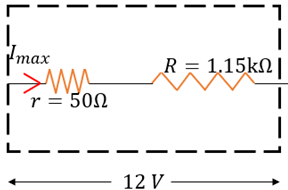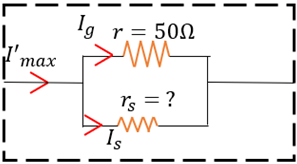A voltmeter coil has resistance 50.0Ω and a resistor of 1.15 kΩ is connected in series. It can read potential differences upto 12 volts. If this same coil is used to construct an ammeter which can measure currents up to 2.0 A, what should be the resistance of the shunt used?
Concepts/Formula used:
Ohm’s Law:
Potential Difference (V) across a resistor of resistance R when current I passes through it is given by Ohm’s law:
![]()
Ammeter:
It consists of a galvanometer coil in parallel with a stunt resistance.
Kirchhoff’s junction rule:
The sum of currents entering a junction is equal to the sum of currents leaving it.
The given voltmeter looks like this:

The maximum potential difference that can be measured is ![]() ,and let the current through the voltmeter for maximum deflection be
,and let the current through the voltmeter for maximum deflection be ![]() .
.
Note that the coil (r) and the other resistor (R) are in series.
![]()
![]()
![]()
![]()
(Note that 1kΩ = 1000Ω )
Now, using Ohm’s law,
![]()
![]()
![]()
The ammeter we want looks like the following diagram:

The maximum current that can be measured is ![]() .
.
From our previous calculations we know that the current through the coil for maximum deflection is ![]() .
.
Note that the shunt resistance (rs) and the coil (r) are parallel in an ammeter.
By Kirchhoff’s junction rule,
![]()
![]()
![]()
Using Ohm’s law, we have
![]()
and
![]()
As rs and r are in parallel, the potential difference across them is the same.
![]()
![]()
![]()
![]()
![]()
Hence, the shunt resistance is 0.251Ω.